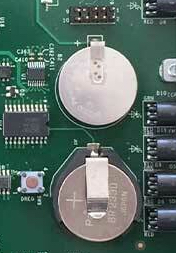|
|
This topic comprises 2 pages: 1 2
|
|
Author
|
Topic: My first deceased ICP certificate battery
|
Leo Enticknap
Film God

Posts: 7474
From: Loma Linda, CA
Registered: Jul 2000
|
 posted 09-05-2019 09:41 PM
posted 09-05-2019 09:41 PM





Thought this was worth mentioning, as the battery being soldered onto the board means that when this happens, a new ICP is needed; which in turn means a big ticket part and potentially significant down time while it is in transit.
This was in an NEC NC3240S-A, that had been manufactured in August 2011. It had only done 18,642 hours before the ICP failure, meaning that it has spent a lot more time powered down than a projector would in a typical multiplex pattern of usage. Given that these ICP batteries are claimed to have an average lifetime of 10 years, and this one has likely lasted 8-9 (I'm assuming that the ICP was manufactured by TI a few months before final assembly of the projector), this sounds about right.
The reported errors when I found it were:
120 : DLP Ack Fail
301 : System Error
302 : Self Test Error
305 : Key Error
306 : Certificate Error
336 : Red Satellite Serial Link Error
337 : Red Satellite Firmware Configuration Error
343 : Green Satellite Serial Link Error
344 : Green Satellite Firmware Configuration Error
350 : Blue Satellite Serial Link Error
351 : Blue Satellite Firmware Configuration Error
370 : ICP Frame Memory Test Result Fail
372 : ICP Data Path Signature Test Result Fail
Obviously, the 306 means that the ICP has gone out, whatever else might be wrong. I did try a firmware reflash just in case, but no luck. Replaced the ICP with a new one today, and after flashing it to 4.54 and restoring the settings backup, all was good.
Just for giggles, I measured the voltage on the cert battery of the dead ICP - 2.48, so that was the problem, alright.
IMHO, there are two takeaways from this. Firstly, owners and operators of early Series 2 projectors, especially those in arthouse and other low hours theaters (that have spent a larger proportion of their life powered down, and therefore with the battery draining), should be prepared to replace their ICP at any moment (a bill likely to be in the mid-four figures). Service techs should be prepared for ICPs to start going out in significant numbers.
| IP: Logged
|
|
|
|
|
|
|
|
|
|
|
|
|
|
|
|
|
|
|
|
Leo Enticknap
Film God

Posts: 7474
From: Loma Linda, CA
Registered: Jul 2000
|
 posted 09-06-2019 09:04 AM
posted 09-06-2019 09:04 AM





Agreed that replacing the battery is theoretically possible. There are two contacts on the underside of the board, covered by a blob of plasticky stuff (presumably to insure against accidental shorting when the board is being handled) - this was what I peeled off on the dead one to measure the voltage. I see no reason why you couldn't solder a 3v source onto those temporarily.
The problem is that if you attempt to do that surgery on a living device, you could kill it if anything goes wrong, which will leave you having to provide the customer with a new, replacement ICP. The only point at which you have nothing to lose is after it's died anyways, at which point it cannot be resurrected.
quote: Marco Giustini
What's the manufacturer's (TI) explanation for soldering the certs battery on the PCB? I'm curious.
It isn't a DCI requirement, because Barco's new ICP-X (the ICP you can buy for the SP4K range, if you don't want to put an Alchemy in it) has user-replaceable batteries: the same dual CR2477N holder as is in the Alchemy, in fact.
When I asked this same question, but in the context of why Dolby were replacing the battery holders in the cat745 with a soldered on battery whenever one is sent in for re-certing, someone (can't remember who - could have been Mark or Harold) suggested that the resistance that can build up on spring-loaded battery terminals can make the contact unreliable over time, especially when the current draw is very low. That is the only justification I can think of besides blatant profiteering.
| IP: Logged
|
|
|
|
|
|
|
|
|
|
|
|
All times are Central (GMT -6:00)
|
This topic comprises 2 pages: 1 2
|
Powered by Infopop Corporation
UBB.classicTM
6.3.1.2
The Film-Tech Forums are designed for various members related to the cinema industry to express their opinions, viewpoints and testimonials on various products, services and events based upon speculation, personal knowledge and factual information through use, therefore all views represented here allow no liability upon the publishers of this web site and the owners of said views assume no liability for any ill will resulting from these postings. The posts made here are for educational as well as entertainment purposes and as such anyone viewing this portion of the website must accept these views as statements of the author of that opinion
and agrees to release the authors from any and all liability.
|

 Home
Home
 Products
Products
 Store
Store
 Forum
Forum
 Warehouse
Warehouse
 Contact Us
Contact Us




 Printer-friendly view of this topic
Printer-friendly view of this topic







![[Smile]](smile.gif)


![[Wink]](wink.gif)




